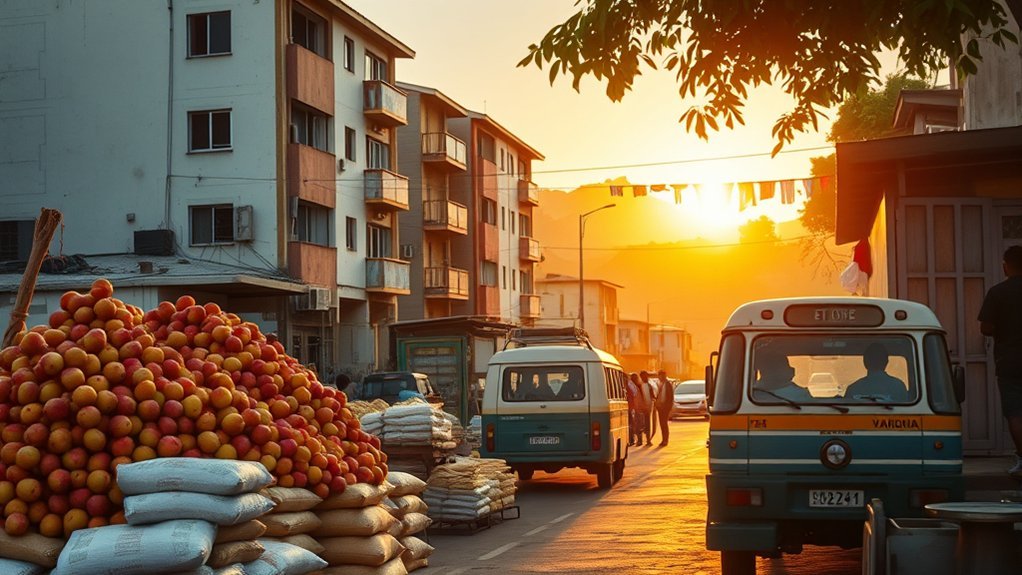You can live in Madagascar on a very tight budget or comfortably in the capital: expect about $210/month outside major cities versus $500–$1,000+ in Antananarivo driven mainly by rent. A one‑bed city‑center apartment averages $271, utilities ~$33.50 and internet ~$49; local transport is cheap (~$0.16/ride or $8.94 monthly pass). Groceries and markets keep food costs low. Salary levels are low, so plan visa fees and housing choices carefully — more practical cost tips and breakdowns follow.
Cost Breakdown: Rent, Utilities and Groceries
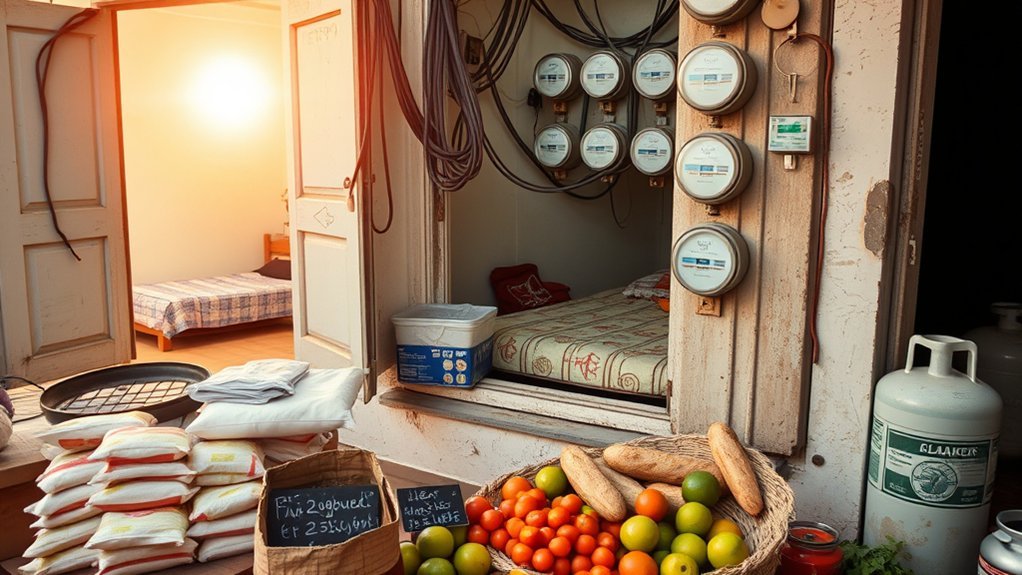
One-bedroom rents in Antananarivo vary widely — about $271/month in the city center versus roughly $69.90 outside it — so you can cut housing costs dramatically by living farther from downtown.
Expect utilities (electricity, water) of around $33.50 monthly and internet at about $49.20, while everyday staples like milk ($1.07/L) and rice ($0.73/kg) keep grocery bills low and a monthly public transit pass costs only $8.94.
Utilities run about $33.50/month, internet $49.20, staples like milk and rice are cheap, and a transit pass is only $8.94.
You’ll plan living expenses around a key trade-off: a centrally located bedroom apartment raises rent substantially, while outskirts options free up cash for discretionary spending or savings.
For a single person, combine rent, utilities and internet to estimate core monthly housing-related cost of living: about $354 in-center versus roughly $153 off-center.
Add basic groceries — milk, rice and other staples — and you’ll likely see total essentials range near $410 (center) or $210 (outside).
These figures help you budget tightly and choose accommodation that matches income and lifestyle priorities.
Eating Out, Transportation and Everyday Expenses
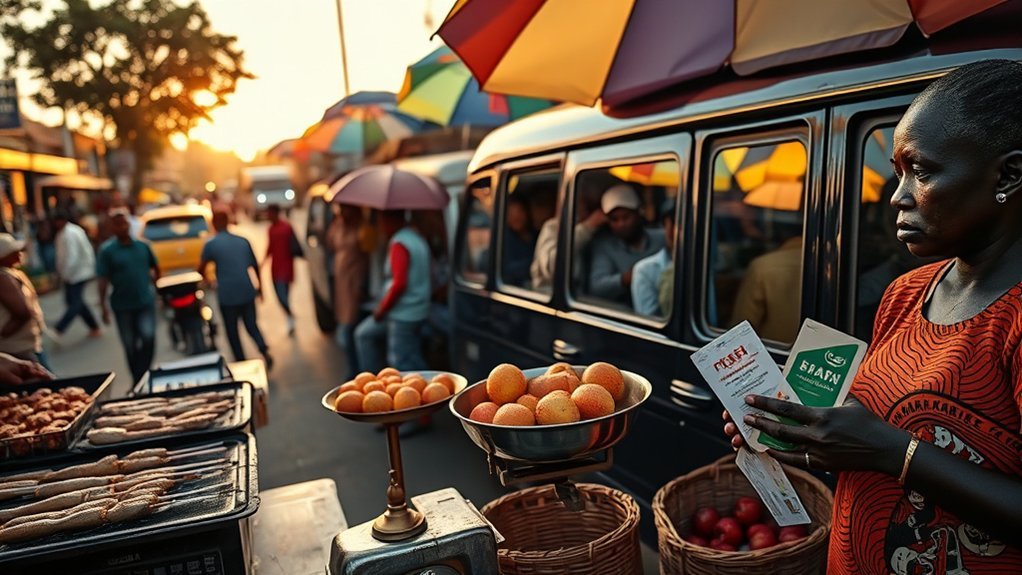
You’ll find eating out is cheap: a lunch menu averages $2.92, a fast-food meal about $4.90, and dinner for two at a mid-range restaurant runs near $18.20.
Local transport is extremely affordable at roughly $0.16 per trip or $8.94 for a monthly pass.
Basic groceries also keep daily costs low—1 L of milk is about $1.07 and 1 kg of rice $0.73.
Typical Meal Prices
Expect to pay very little for everyday meals and transport in Madagascar: a lunch menu averages about $2.92, fast-food meals run near $4.90, and a dinner for two is roughly $18.20.
Local transport costs just $0.16 per ride (or about $8.94 monthly), and staples like milk and rice are around $1.07 per liter and $0.73 per kilogram respectively.
You’ll find meal prices that pull the Price Index well below that of developed countries, so your food budget will be small compared with many places.
If you eat out occasionally and buy basic groceries, monthly food spending stays modest.
Use these figures to project weekly and monthly food budgets, compare to rent and utilities, and plan realistic living costs.
Local Transport Costs
Because local fares are tiny, getting around Madagascar won’t push your monthly budget, with single-ride tickets costing about $0.16 and an unlimited monthly pass priced at $8.94.
You’ll find local transport affordable and predictable: ticket prices keep daily commuting expenses minimal, so you can compare transport costs directly against meal prices (lunch ~$2.92, fast food ~$4.90, dinner for two ~$18.20) when planning your budget.
For short hops, single tickets are best; if you commute regularly, the monthly pass reduces per-ride cost considerably.
Commuting options include buses and shared taxis that cover urban routes cheaply.
Factor in occasional rideshare or private taxi surcharges, but overall local transport remains one of the lowest recurring costs.
Daily Grocery Essentials
Anyone shopping in Madagascar will find daily essentials very affordable: basic groceries like rice cost about $0.73/kg and milk $1.07/L, while eating out remains cheap—lunch menus run ~$2.92, fast-food meals ~$4.90, and a restaurant dinner for two averages $18.20—so you can balance cooking at home against occasional meals out; add modest local transport ($0.16 per ride or $8.94/month) and utilities (~$33.50/month) to estimate a lean monthly living cost precisely.
You’ll save most by buying staples in bulk at local markets, where local market insights show lower per-unit prices than supermarkets.
Use grocery shopping tips: compare stalls, seasonally shift purchases to exploit seasonal price variations, and prioritize rice, legumes and local produce to keep food costs minimal.
Typical Salaries and Purchasing Power
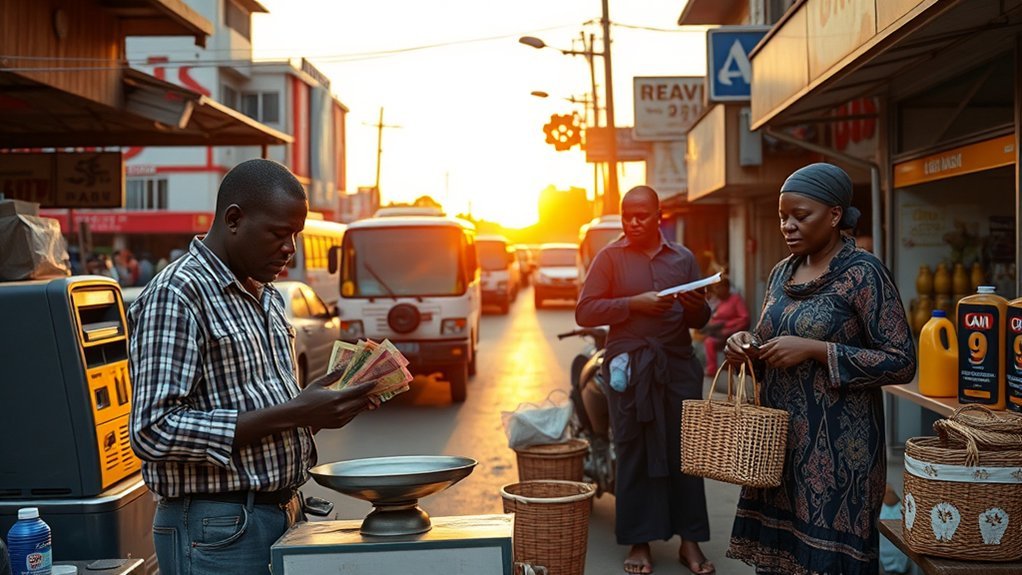
You’ll find average net wages in Madagascar are about $111 per month after tax, which is far below basic expenses.
At a roughly $520 monthly cost of living, that wage only covers about 0.2 months, showing a large gap between pay and needs.
Purchasing power is low—Madagascar ranks 185th globally and is about 2.2 times cheaper than the world average, but wages haven’t kept pace with even those lower prices.
Average Net Wages
Although salaries in Madagascar are low compared with global standards, they directly shape what you can afford: the average net wage is about $111 per month after tax, which covers only roughly 0.2 months of the country’s average monthly cost of living (around $520).
You’ll face stark average income disparities: urban formal workers and expatriates can access higher pay while rural and informal sectors earn far less. Employment opportunities concentrate in agriculture, mining, tourism, and public service, limiting upward mobility for many.
Given Madagascar’s 185th ranking for cost of living and purchasing power, your budget will be tightly constrained; $111 rarely covers basic necessities.
These economic challenges mean you should plan finances conservatively and seek higher-paying or supplemented income streams.
Wage vs. Living Costs
Having seen average net wages, it helps to compare those earnings directly with typical costs so you can judge purchasing power.
You’ll note the average after-tax salary is about $111/month while basic living costs run near $520 — you cover only 0.2 months of expenses on that wage, a stark indicator of wage disparity.
Rent for a decent one-bedroom in Antananarivo is at least €300, consuming most of monthly income and depressing living standards.
Even though Madagascar’s cost of living ranks low globally, local earnings don’t keep up, so your purchasing power is severely limited.
These economic challenges force tough choices: prioritize housing, reduce consumption, or rely on remittances and informal income to bridge gaps.
Purchasing Power Parity
Because local prices run about 2.2 times below the global average, your money goes further on many goods and services in Madagascar—but that advantage is sharply undercut by very low wages.
The average after-tax salary is roughly $111/month, while a modest monthly lifestyle with rent and utilities costs €500–€1,000, so median earnings cover only about 0.2 months of necessary expenses.
That gap erodes purchasing power for most residents and highlights stark economic disparity. You’ll see reasonable unit prices, but income inequality prevents broad access to them.
The Human Freedom Index (6.67) and low wages combine to constrain household budgets, force reliance on informal income, and make budgeting for housing and basic services a persistent challenge.
Living in Antananarivo vs. Regional Cities
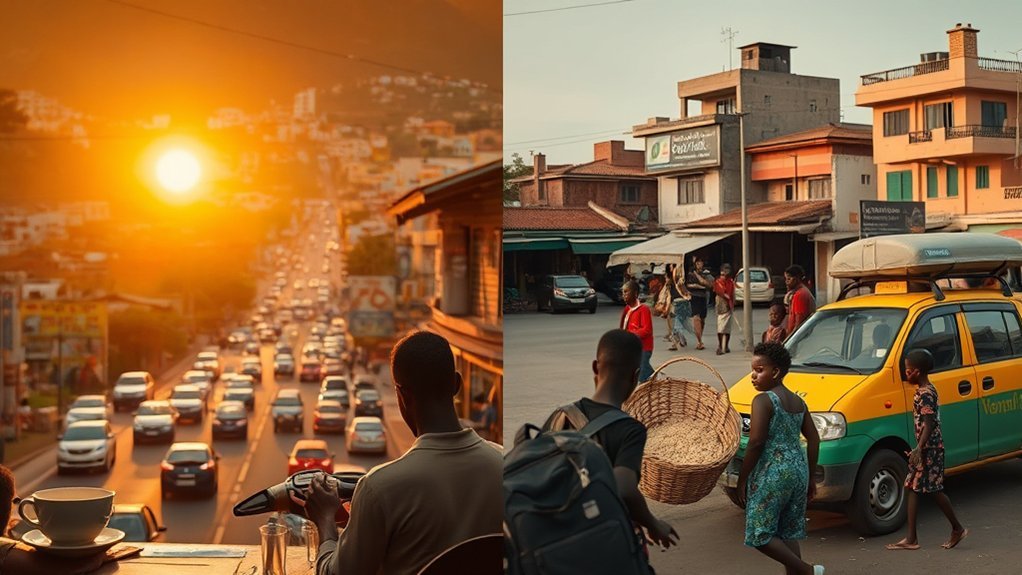
When you compare Antananarivo to regional cities, living costs in the capital are noticeably higher: average monthly expenses run about €500–€1,000 versus substantially lower figures outside the capital.
You’ll see urban lifestyle differences in every line item: housing market trends push a decent 1‑bedroom in Tana to at least €300, while regional alternatives can drop to roughly $69.90.
Utilities in the capital average about $33.50 per person; regional supply and service levels can change that number.
Dining is costlier too — a dinner for two in Antananarivo averages $18.20, often less elsewhere.
Public transport fares are cheap in the capital (around $0.16 per ride), but frequency and convenience vary by neighborhood and region.
If you’re planning budget projections, treat Antananarivo as a premium baseline and regional cities as lower-cost options with trade-offs in amenities and the cultural experiences contrast between metropolitan convenience and more traditional, less expensive local living.
Tips for Saving Money and Finding Accommodation
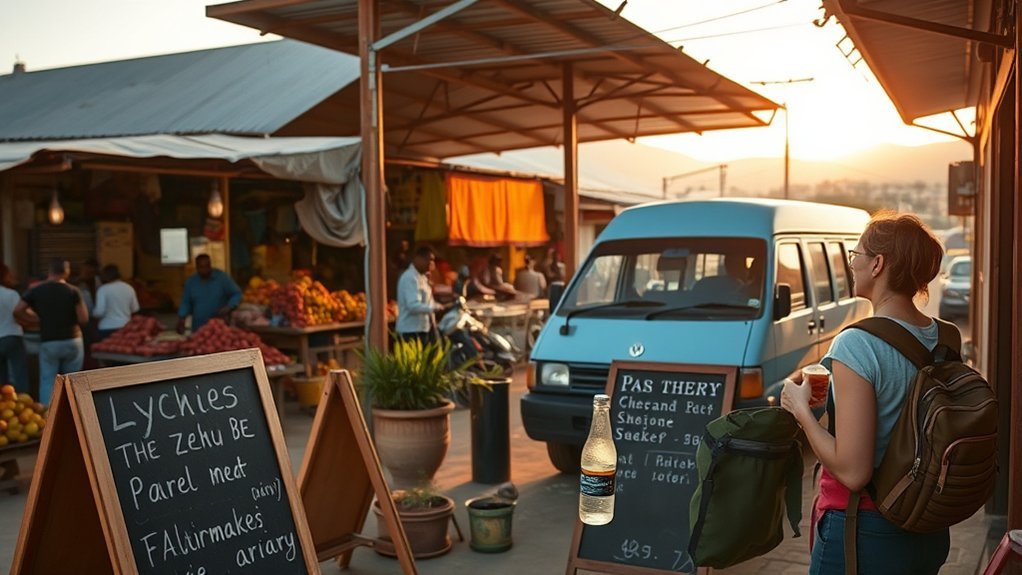
If you’re comparing Antananarivo to regional cities, the obvious next step is to look at concrete ways to cut housing and living costs. You can rent a cheap 1-bedroom outside the city center for about $69.90/month versus $271 in the center.
Prioritize neighborhoods with public transport—tickets cost $0.16—so you reduce commuting expenses. Factor utilities into decisions: a single person’s bill averages $33.50, and many rental agreements bundle them, smoothing monthly budgeting.
Look to local online expat communities for shared housing options or sublets; pooling rent and utilities can slash costs. Use local marketplaces for groceries—milk $1.07/L, rice $0.73/kg—to lower food spending.
- Imagine paying a third of city rent and still living close to transit.
- Picture splitting utilities and not worrying about surprise bills.
- Feel the relief of predictable monthly expenses when you choose smart rentals.
Be proactive: verify rental agreements, compare listings, and negotiate for bundled utilities.
Visas, Work Permits and Practical Considerations
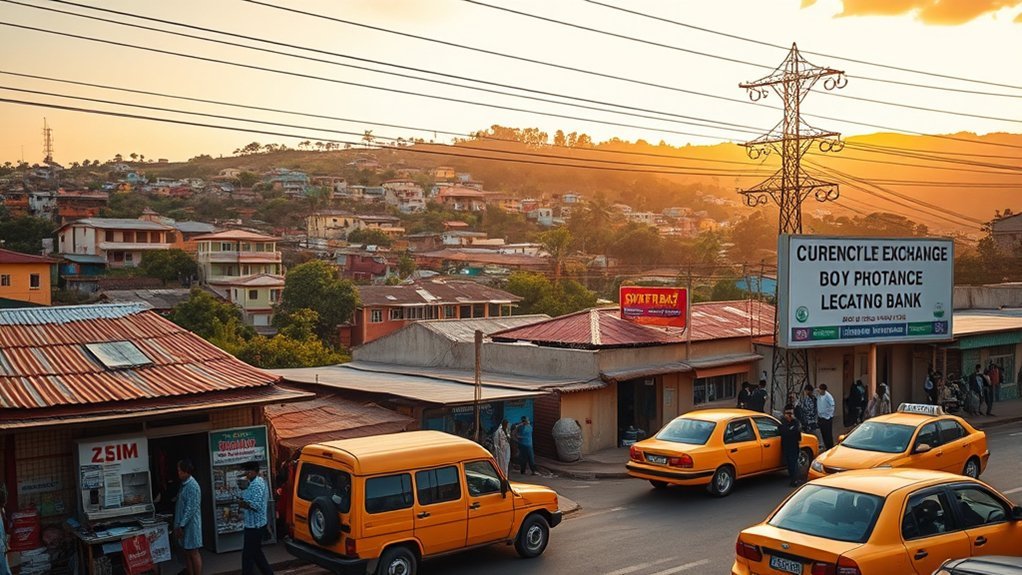
Although tourist visas let you stay up to two months (with a one‑month extension possible), planning longer stays requires understanding volunteer visa options and the work‑permit process so you don’t face unexpected costs or delays.
You’ll typically use volunteer visas for extended programs (Peace Corps, Fulbright); budget for program fees and potential local registration costs.
If you plan to work, factor in work permit regulations: employers usually sponsor permits, and application fees, processing time and legal assistance can add several hundred dollars.
Before committing, visit for a short stay to assess living costs and compatibility; this avoids paying for a resident visa that doesn’t fit your needs.
Study visa application processes carefully: required documents, apostilles, translations and courier fees are common line items.
For residency requirements overview, note length-of-stay thresholds and renewal timelines—missing deadlines triggers fines or exit charges.
In short, model scenarios with one-off visa fees, monthly living costs and potential permit-related legal fees to estimate your true cost of living in Madagascar.
Frequently Asked Questions
How Much Do You Need to Live Comfortably in Madagascar?
You’ll need about €500–€1,000 monthly; cost breakdown shows rent (~€300), utilities (~$33.5), internet (~$49.2), food and dining; use lifestyle expenses and budget planning to align expectations and cover local salary gaps practically.
Is Madagascar a Good Place to Live In?
Yes — you’ll find cultural diversity, affordable costs, a small expat community, and rich local cuisine, but you’ll need to budget cautiously given low local incomes, moderate freedoms, and limited services if you want a comfortable lifestyle.
What Is the Average Price of a House in Madagascar?
You’ll typically find average house prices in Madagascar varying widely—around $10,000–$70,000 nationwide—reflecting housing market trends, regional price variations, and property investment opportunities; factor location, amenities, utilities, and maintenance for realistic budgeting.
How Much Is the Average Rent in Madagascar?
You’ll pay about $70 outside city centers and roughly $271 for a one-bedroom downtown; three-bedroom city rents average $515. Check affordable neighborhoods, compare rent prices, and monitor the housing market for cost-focused, practical choices.
Conclusion
Living in Madagascar can be surprisingly affordable if you plan wisely: rent and groceries are low, but imported goods, utilities and eating out add up. Aim for Antananarivo if you need better salaries—else regional cities cut costs. Expect modest wages, factor visa and permit fees, and hunt local markets and long-term rentals to stretch your budget. Like a compass pointing to savings, your choices will steer real purchasing power—be practical, budgeted and flexible.

